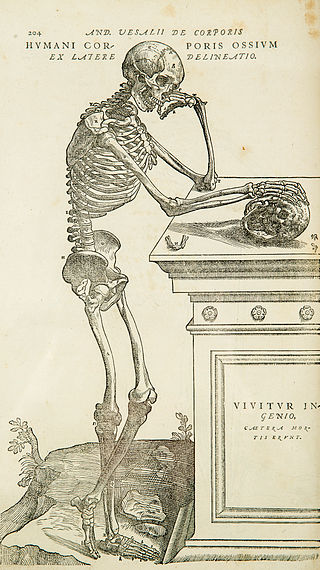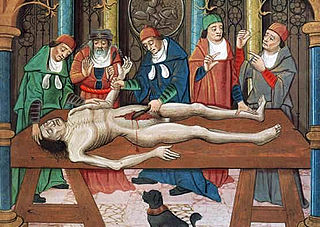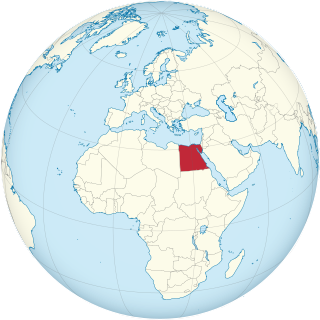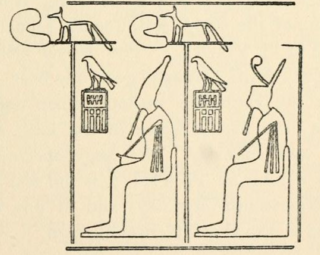
The Ancient Egyptian anatomical studies is an article about the history of anatomy within ancient Egypt.

The Ancient Egyptian anatomical studies is an article about the history of anatomy within ancient Egypt.
From a period spanning the time beginning at about 3100 B.C. to the finish of the 2nd century A.D., anatomical studies were fore-most within the ancient Egyptian nation, than within other parts of the world, according to archaeological evidence. People of the ancient Egyptian civilization initiated an independent practice of anatomical study, which represented the first movement within humanity toward the development of an understanding of anatomy; Egypt is where the study of anatomy historically first developed. People belonging to the Egyptian nation were the first to make a written record of anatomical studies. [1] [2] [3]
Manetho is thought to have recorded the work of an early anatomist. In his work History of Egypt Manetho states the pharaoh Djer was an anatomist, although a source considers the likelihood of the pharaoh being an anatomist to be low. Djer is stated to have been the first to have made a written work on the study of anatomy, entitled Practical Medicine and Anatomical Book, which is known of, but not extant, although this attribution may represent an honorific observance indicating the book was written within the reign of the pharaoh, within which the book is known to have been written. [2] [4] [5]
Two individuals, Herophilus, and Erasistratus, both living within Alexandria and participating within the so-called School of Alexandria, both contributed to anatomical understanding and knowledge, as they began a practice of human dissection. [1] [6]
Egyptian civilization was responsible for the advent of terms for external body parts, of all body parts practitioners were aware of, metu, understood to refer to the heart, was central to ancient understandings of anatomy within relevant areas of Egypt. [7]
Knowledge of anatomical studies is drawn from papyri and ostraca, especially the Ebers, Edwin Smith and Kahun Papyri. One of only two extant texts on creating a mummy is the Ritual of Embalming Papyrus. Mummification techniques led to advancement in anatomical knowledge. [1] [2] [8] [9]
The Ebers Papyrus describes metu, which is a word referring to vascular structures, ducts, tendons, or perhaps nerves, which run to various parts of the human head, of these there are a number amounting to fifty-two metu described within the Ebers. [2]
The Edwin Smith Papyrus shows the very first use of the word brain, and details information on the meninges and cerebrospinal fluid. The text describes in appreciably realistic terms, anatomical structures while detailing injuries in order of anatomy. [10]

Anatomy is the branch of biology concerned with the study of the structure of organisms and their parts. Anatomy is a branch of natural science that deals with the structural organization of living things. It is an old science, having its beginnings in prehistoric times. Anatomy is inherently tied to developmental biology, embryology, comparative anatomy, evolutionary biology, and phylogeny, as these are the processes by which anatomy is generated, both over immediate and long-term timescales. Anatomy and physiology, which study the structure and function of organisms and their parts respectively, make a natural pair of related disciplines, and are often studied together. Human anatomy is one of the essential basic sciences that are applied in medicine.

The history of anatomy extends from the earliest examinations of sacrificial victims to the sophisticated analyses of the body performed by modern anatomists and scientists. Written descriptions of human organs and parts can be traced back thousands of years to ancient Egyptian papyri, where attention to the body was necessitated by their highly elaborate burial practices.

Articles related to Egypt include:

The Ebers Papyrus, also known as Papyrus Ebers, is an Egyptian medical papyrus of herbal knowledge dating to c. 1550 BCE. Among the oldest and most important medical papyri of Ancient Egypt, it was purchased at Luxor in the winter of 1873–1874 by the German Egyptologist Georg Ebers. It is currently kept at the Leipzig University Library in Germany.

Manetho is believed to have been an Egyptian priest from Sebennytos who lived in the Ptolemaic Kingdom in the early third century BC, during the Hellenistic period. He authored the Aegyptiaca in Greek, a major chronological source for the reigns of the kings of ancient Egypt. It is unclear if he wrote his history and king list during the reign of Ptolemy I Soter or Ptolemy II Philadelphos, but it was completed no later than that of Ptolemy III Euergetes.

The Twelfth Dynasty of ancient Egypt is considered to be the apex of the Middle Kingdom by Egyptologists. It often is combined with the Eleventh, Thirteenth, and Fourteenth dynasties under the group title, Middle Kingdom. Some scholars only consider the 11th and 12th dynasties to be part of the Middle Kingdom.

Djer is considered the third pharaoh of the First Dynasty of ancient Egypt in current Egyptology. He lived around the mid-thirty-first century BC and reigned for c. 40 years. A mummified forearm of Djer or his wife was discovered by Flinders Petrie, but was discarded by Émile Brugsch.

The Edwin Smith Papyrus is an ancient Egyptian medical text, named after Edwin Smith who bought it in 1862, and the oldest known surgical treatise on trauma. From a cited quotation in another text, it may have been known to ancient surgeons as the "Secret Book of the Physician".

The medicine of the ancient Egyptians is some of the oldest documented. From the beginnings of the civilization in the late fourth millennium BC until the Persian invasion of 525 BC, Egyptian medical practice went largely unchanged and included simple non-invasive surgery, setting of bones, dentistry, and an extensive set of pharmacopoeia. Egyptian medical thought influenced later traditions, including the Greeks.
Articles related to Modern Egypt include:

Egyptian medical papyri are ancient Egyptian texts written on papyrus which permit a glimpse at medical procedures and practices in ancient Egypt. These papyri give details on disease, diagnosis, and remedies of disease, which include herbal remedies, surgery, and magical incantations. Many of these papyri have been lost due to grave robbery. The largest study of the medical papyri to date has been undertaken by Humboldt University of Berlin and was titled Medizin der alten Ägypter.

The Brooklyn Papyrus is a medical papyrus dating from ancient Egypt and is one of the oldest preserved writings about medicine and ophiology. The manuscript is dated to around 450 BCE and is today kept at the Brooklyn Museum in New York.
The Ramesseum medical papyri constitute a collection of ancient Egyptian medical documents dating back to the early 18th century BC, found in the temple of the Ramesseum. As with most ancient Egyptian medical papyri, these documents mainly dealt with ailments, diseases, the structure of the body, and proposed remedies used to heal these afflictions, namely ophthalmologic ailments, gynaecology, muscles, tendons, and diseases of children. It is the only well-known papyrus to describe these in great detail. Most of the text written in the known manuscripts of this collection are in parts III, IV, and V, and written in vertical columns.

The Heqanakht papyri or Heqanakht letters are a group of papyri dating to the early Middle Kingdom of Ancient Egypt that were found in the tomb complex of Vizier Ipi. Their find was located in the burial chamber of a servant named Meseh, which was to the right side of the courtyard of Ipi's burial complex. It is believed that the papyri were accidentally mixed into debris used to form a ramp to push the coffin of Meseh into the chamber. The papyri contain letters and accounts written by Heqanakht, a ka-priest of Ipi. Heqanakht himself was obliged to stay in the Theban area, and thus wrote letters to his family, probably located somewhere near the capital of Egypt at that time, near the Faiyum. These letters and accounts were somehow lost and thus preserved. The significance of the papers is that they give rare and valuable information about lives of ordinary members of the lower upper class of Egypt during this period.

The following outline is provided as an overview of a topical guide to ancient Egypt:
This page list topics related to ancient Egypt.
The Ritual of Embalming Papyrus or Papyrus of the Embalming Ritual is one of only two extant papyri which detail anything at all about the practices of mummification used within the burial practices of Ancient Egyptian culture.

The Apis Papyrus is an ancient Egyptian artifact, the work of scribes upon papyrus, concerning the Apis bull.

The Alexandria School of Medicine is one of the oldest empirical educational institutions in the history of medicine initiated during the Hellenistic period in the city of Alexandria. At one historical juncture, in Egypt, they united all the different medical doctrines that originated in the East and in Alexandria, and merged into one universal "critical mass of knowledge" the Alexandrian empirical school. As the Alexandria School grows more developed Medical Schools in Knossos and in Knidos over time lost their meaning and significance.